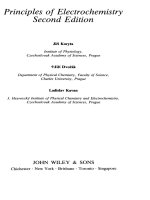Modern aspects of electrochemistry no 18 white
Bạn đang xem bản rút gọn của tài liệu. Xem và tải ngay bản đầy đủ của tài liệu tại đây (6.29 MB, 374 trang )
LIST OF CONTRIBUTORS
L. I. BOGUSLAVSKY
A. N. Frumkin Institute of Electrochemistry
Academy of Sciences of the USSR
Moscow, USSR
MARK E. ORAZEM
Department of Chemical Engineering
University of Virginia
Charlottesville, Virginia
LAURENCE D. BURKE
Chemistry Department
University College Cork
Cork, Ireland
PAUL J. SIDES
Department of Chemical Engineering
Carnegie-Mellon University
Pittsburgh, Pennsylvania
F. HINE
Nagoya Institute of Technology
Nagoya, Japan
B. V. TILAK
Occidental Chemical Corporation
Research Center
Grand Island, New York
HIDEAKI KITA
Department of Chemistry
Faculty of Science
Hokkaido University
Sapporo, Japan
MICHAEL E. G. LYONS
Chemistry Department
Trinity College
Dublin, Ireland
JOHN NEWMAN
Materials and Molecular Research Division
Lawrence Berkeley Laboratory
and Department of Chemical Engineering
University of California
Berkeley, California
KOHEI UOSAKI
Department of Chemistry
Faculty of Science
Hokkaido University
Sapporo, Japan
K. VISWANATHAN
Occidental Chemical Corporation
Research Center
Grand Island, New York
A Continuation Order Plan is available for this series. A continuation order will bring
delivery of each new volume immediately upon publication. Volumes are billed only
upon actual shipment. For further information please contact the publisher.
MODERN ASPECTS OF
ELECTROCHEMISTRY
No. 18
Edited by
RALPH E. WHITE
Department of Chemical Engineering
Texas A&M University
College Station, Texas
J. O'M. BOCKRIS
Department of Chemistry
Texas A&M University
College Station, Texas
and
B. E. CONWAY
Department of Chemistry
University of Ottawa
Ottawa, Ontario, Canada
PLENUM PRESS • NEW YORK AND LONDON
The Library of Congress cataloged the first volume of this title as follows:
Modern aspects of electrochemistry, no. [1]
Washington, Butterworths, 1954v. illus., 23 cm.
No. 1-2 issued as Modern aspects series of chemistry.
Editors: no. 1J. Bockris (with B. E. Conway, No. 3 )
Imprint varies: no. 1, New York, Academic P r e s s . - N o . 2, London, Butterworths.
1. Electrochemistry —Collected works. I. Bockris, John O'M. ed. II. Conway, B. E.
ed.
(Series: Modern aspects series of chemistry)
QD552.M6
54-12732 rev
ISBN 0-306-42312-X
© 1986 Plenum Press, New York
A Division of Plenum Publishing Corporation
233 Spring Street, New York, N.Y. 10013
All rights reserved
No part of this book may be reproduced, stored in a retrieval system, or transmitted
in any form or by any means, electronic, mechanical, photocopying, microfilming,
recording, or otherwise, without written permission from the Publisher
Printed in the United States of America
Preface
This volume of Modem Aspects of Electrochemistry contains six
chapters. The first four chapters are about phenomena of interest
at the microscopic level and the last two are on phenomena at the
macroscopic level.
In the first chapter, Uosaki and Kita review various theoretical
models that have been presented to describe the phenomena that
occur at an electrolyte/semiconductor interface under illumination.
In the second chapter, Orazem and Newman discuss the same
phenomena from a different point of view. In Chapter 3, Boguslavsky presents state-of-the-art considerations of transmembrane
potentials and other aspects of active transport in biological systems.
Next, Burke and Lyons present a survey of both the theoretical
and the experimental work that has been done on hydrous oxide
films on several metals.
The last two chapters cover the topics of the production of
chlorine and caustic and the phenomena of electrolytic gas evolution. In Chapter 5, Hine et al. describe the engineering aspects of
the three processes used in the chlor-alkali industry, and in Chapter
6, Sides reviews the macroscopic phenomena of nucleation, growth,
and detachment of bubbles, and the effect of bubbles on the conductivity of and mass transfer in electrolytes.
Texas A&M University
Texas A&M University
University of Ottawa
R. E. White
J. O'M. Bockris
B. E. Conway
Contents
Chapter 1
THEORETICAL ASPECTS
OF SEMICONDUCTOR ELECTROCHEMISTRY
Kohei Uosaki and Hideaki Kita
I. Introduction
II. Electronic Energy Levels of Semiconductor and
Electrolyte
1. Junctions between Two Electronic Conductors . . . .
2. Semiconductor/ Electrolyte Interface
III. Potential Distribution at Semiconductor/Electrolyte
Interface
1. Schottky Barrier
2. Effect of the Redox Potential on the Potential
Drop in the Semiconductor at the
Semiconductor/Electrolyte Interfaces
3. Distribution of Externally Applied Potential at the
Semiconductor/Electrolyte Interfaces
IV. Distribution of Energy States for Ions of Redox
System in Solution
1. Importance of the Energy Levels of Redox Couples
2. Gurney's Model
3. Gerischer's Model
4. Continuum Solvent Polarization Fluctuation Model
5. Validity of the Models
Vll
1
2
2
4
13
14
15
20
23
23
24
29
32
35
viii
Contents
V. Rate Expressions for Electron Transfer at Illuminated
Semiconductor/Electrolyte Interfaces
1. Phenomenological Description
2. The Model of Bockns and Uosaki
3. Butler's Model—Semiconductor/Electrolyte
Interface as a Schottky Barrier
4. Competition between Surface Recombination and
Charge Transfer
5. Effects of Recombination in Space Charge Region
6. Effects of Grain Boundary Recombination
VI. Concluding Remarks
References
37
37
38
42
45
51
53
54
55
Chapter 2
PHOTOELECTROCHEMICAL DEVICES
FOR SOLAR ENERGY CONVERSION
Mark E. Orazem and John Newman
I. Semiconductor Electrodes
1. Physical Description
2. The Mechanism of Cell Operation
II. Mathematical Description
1. Semiconductor
2. Electrolyte
3. Semiconductor-Electrolyte Interface
4. Boundary Conditions
5. Counterelectrode
III. Photoelectrochemical Cell Design
1. Choice of Materials
2. Solution of the Governing Equations
3. The Influence of Cell Design
IV. Conclusions
Notation
References
62
63
66
69
70
76
78
82
83
84
85
87
91
98
99
101
Contents
ix
Chapter 3
ELECTRON TRANSFER EFFECTS AND THE
MECHANISM OF THE MEMBRANE POTENTIAL
L. I. Boguslavsky
I. Introduction
II. Modeling Nonenzymatic Systems of Electron Transfer
in the Initial Part of the Respiratory Chain of
Mitochondria
1. Respiratory Chain
2. Potentials of the Respiratory Chain Elements
3. Ubiquinones in the Respiratory Chain
4. Participation of Membrane Lipids in the
Functioning of the Respiratory Chain
5. Transmembrane Potentials in the Chain NADHCoenzyme Q-O 2
6. Participation of FMN in the Oxidation of
Membrane Lipids
7. Participation of FMN in the Transmembrane
Transport of Protons
8. Participation of FMN in the Transmembrane
Transport of Electrons
9. Interaction of FMN with Other Chain Components
III. Potential Generation on Bilayer Membranes
Containing Chlorophyll
1. Chlorophyll at the Membrane/Electrolyte Interface
2. Redox Potentials of Chlorophyll
3. Reactions of Chlorophyll Inserted in the
Membrane with the Redox Components in an
Aqueous Solution under Illumination
4. Transmembrane Potentials in the Chain OX-CHLRED
IV. Possible Mechanisms of the Motion of Electrons and
Protons in the Membrane
1. Hypotheses on the Mechanism of Electron Motion
in Biological Membranes
113
115
115
116
118
119
122
127
130
134
135
137
137
138
138
141
144
145
x
Contents
2. Ion Permeability of Bilayer Membranes in the
Iodine/Iodide System Controlled by Redox
Reactions at the Interface
3. Electron and Proton Transport in Bilayers
Containing Chlorophyll and Quinones under
Illumination
4. Possible Conductance Mechanisms in Bilayers
Containing Ubiquinone
5. Hypothesis on the Mechanism of Proton Transport
in Biological Membranes
6. Potentials of Coupling Membranes
V. Conclusions
References
148
151
152
153
155
161
163
Chapter 4
ELECTROCHEMISTRY OF
HYDROUS OXIDE FILMS
Laurence D. Burke and Michael E. G. Lyons
I.
II.
III.
IV.
V.
VI.
Introduction
Formation of Hydrous Oxides
Acid-Base Properties of Oxides
Structural Aspects of Hydrous Oxides
Transport Processes in Hydrous Oxide Films
Theoretical Models of the Oxide-Solution
Interphase Region
1. Classical Models
2. Nonclassical Models
VII. Platinum
1. Monolayer Oxidation
2. Hydrous Oxide Growth on Platinum
VIII. Palladium
IX. Gold
1. Monolayer Behavior
2. Hydrous Oxide Growth
169
171
173
179
182
188
189
189
191
191
198
205
208
208
210
Contents
xi
X. Iridium
1. Monolayer Growth
2. Hydrous Oxide Films
XI. Rhodium
1. Hydrous Oxide Growth
2. Behavior of Rh/Pt Alloys
XII. Ruthenium
XIII. Some Nonnoble Metals
1. Iron and Cobalt
2. Nickel and Manganese
3. Tungsten
XIV. Conclusion
Addendum
References
213
213
214
224
224
226
227
230
230
233
238
239
241
243
Chapter 5
CHEMISTRY AND CHEMICAL ENGINEERING
IN THE CHLOR-ALKALI INDUSTRY
F. Hine, B. V. Tilak, and K. Viswanathan
I. Introduction
II. Chemical and Electrochemical Principles Involved in
Chlor-Alkali Production
III. Manufacturing Processes
1. Importance of Brine Purification
2. Diaphragm Cell Process
3. Membrane Cell Process
4. Mercury Cell Process
IV. Electrode Materials and Electrode Processes
1. Anodes
2. Cathodes
V. Engineering Aspects in Chlor-Alkali Operations
1. Chemical Engineering Aspects of Amalgam
Decomposition
2. Chemical Engineering Aspects of Porous
Diaphragms
249
250
253
253
256
259
260
263
263
268
270
270
279
xii
VI. Ion-Exchange Membranes and Membrane Technology
1. General Requirements of Membranes for ChlorAlkali Production
2. Properties of Membranes and Their Performance
Characteristics
3. Engineering Design Aspects of Ion-Exchange
Membrane Cell Technology
4. Advantages Afforded by Membrane Technology . . .
5. State of the Art of Membrane Cell Technology
Notation
References
Contents
287
287
288
292
295
296
297
298
Chapter 6
PHENOMENA AND EFFECTS OF ELECTROLYTIC
GAS EVOLUTION
Paul J. Sides
I. Introduction
II. Nucleation, Growth, and Detachment of Bubbles . . . .
1. Nucleation
2. Growth
3. Detachment
4. Effect of Additives and Operating Parameters
III. Electrical Effects of Gas Evolution
1. Conductivity of Bulk Dispersions
2. Electrical Effects of Bubbles on Electrodes
IV. Mass Transfer at Gas-Evolving Electrodes
1. Penetration Theory
2. The Hydrodynamic Model
3. The Microconvection Model
4. Microscopic Investigation
V. Summary
Notation
References
303
304
304
306
312
315
318
318
330
342
342
344
347
348
348
349
352
Index
355
Theoretical Aspects of
Semiconductor Electrochemistry
Kohei Uosaki and Hideaki Kita
Department of Chemistry, Faculty of Science, Hokkaido University, Sapporo 060, Japan
I. INTRODUCTION
The history of semiconductor photoelectrochemistry started over
100 years ago when Becquerel found that an electric current flowed
if one of the electrodes immersed in a dilute acid was illuminated
by light.1 Although the concept of a semiconductor did not exist
at that time, it is now clear that the electrodes which Becquerel
used had semiconductor properties. In 1955, Brattain and Garrett
used germanium as the first semiconductor electrode.2 Since then
the knowledge of semiconductor electrochemistry has grown
steadily and several reviews and books on this subject have
appeared.310 The research activity in this field, however, has grown
quite significantly in the last decade or so, following the suggestion
by Fujishima and Honda that solar energy may be directly converted
to a chemical energy, hydrogen, by using semiconductor/aqueous
electrolyte solution/metal cells.11 Just after their paper was published, a worldwide search for new alternative energy sources began,
and this process, photoelectrochemical energy conversion, attracted
many research groups as one of the possible means to convert solar
energy to electrical or chemical energy. After 10 years of intensive
research, not only has the solar conversion efficiency of photoelectrochemical devices exceeded 10%12 and the application of this
process widened,13 but also the progress of the theoretical under-
2
Kohei Uosaki and Hideaki Kita
standing of the process is quite significant.14'15 Because of its multidisciplinary nature, research workers in this field have a very wide
variety of backgrounds such as solid state physics, inorganic
chemistry, photochemistry, catalytic chemistry, and, of course,
electrochemistry. This diverse background is an advantage on the
one hand but makes communication between the research workers
with different backgrounds difficult.16 Many theories and models
developed for semiconductor/metal and semiconductor/semiconductor interfaces have been applied to semiconductor/electrolyte
interfaces without considering the unique nature of this system.
Some of the confusion has been resolved already, but there are still
many points to be made clear. Thus, the present authors thought
it would be useful to write an article on theoretical aspects of
semiconductor electrochemistry which can, hopefully, clarify many
theoretical ambiguities in the semiconductor electrochemistry and
bridge the gap between solid state physics oriented research workers
and electrochemistry oriented ones.
The stress will be given to the similarities and the differences
between the semiconductor/metal and semiconductor/semiconductor interfaces where charge carriers are electrons and holes in
both phases and the semiconductor/electrolyte interfaces where
charge carriers are electrons and holes in a semiconductor phase
but cations and anions in an electrolyte.
II. ELECTRONIC ENERGY LEVELS OF
SEMICONDUCTOR AND ELECTROLYTE
One of the most important theoretical problems in semiconductor
electrochemistry is the understanding of the nature of the semiconductor/electrolyte interfaces. Knowledge of the electronic energy
levels of the semiconductor and the electrolyte is essential to
describe the interface.
1. Junctions between Two Electronic Conductors
When metal/metal, semiconductor/semiconductor, or semiconductor/metal junctions are under consideration, the relative positions
of the Fermi levels before contact or the work functions of two
Theoretical Aspects of Semiconductor Electrochemistry
3
phases determine the nature of contact. Let us first consider the
metal/metal contact.17 Figure la shows the electronic energy levels
of two metals before contact. O M l and O™2 represent the work
function of Mx and M2, respectively. When two metals are in contact,
the Fermi levels of two metals must be the same. In other words,
where /Z^1 is the electrochemical potential of an electron in a metal,
M. To achieve this, electrons should flow from Mx to M2 because
originally E FMi > EFMl. At equilibrium, M 2 is charged negatively
while Mj is positively charged and a potential difference builds up
at the interface. The electrochemical potential of the electron is
given by18
(Le =
(2)
= ae -
where ae is the reverse of the electron work function which is the
minimum work required to extract electrons from an uncharged
" Vacuum
level
-F.M,
F.M2
(a) Before contact
Figure 1. Energy diagram of
metal/metal junction (a) before
and (b) after contact. See text for
notations.
/
(b) After contact
4
Kohei Uosaki and Hideaki Kita
metal19 and is called the real potential and W is the Volta potential
governed by the charge on the metal surface. From (1) and (2),
e(^ M > - ^ M 0 = a™* - a™i = <S>M> - <J>Mi
(3)
The situation after contact is schematically shown in Fig. lb. (^ M l ^ M 2 ) is known as a contact potential and is an absolute, measurable
quantity. Here one must note, however, that ^ M l and ^ M 2 separately
depend on the size of the phases Mx and M2, respectively, and are
not absolute quantities. Thus, /I™, which contains ^ M , is not an
absolute quantity either.
The above arguments are easily applicable to semiconductor/metal and semiconductor/semiconductor junctions where the
electronic energy level of both phases can also be represented by
the Fermi level. The major difference between these two junctions
and the metal/metal contact is that while in the case of the latter
system, A^( = ^ M 2 - ^ M *) develops only within several angstroms
of the interface, A ^ extends to very deep into the bulk of semiconductor in the case of the junctions which involve a semiconductor
phase because the semiconductor has fewer frees carriers than a
metal. The situation is shown schematically in Figs. 2a and 2b.20
2. Semiconductor/Electrolyte Interface
Now let us turn to the semiconductor/electrolyte interface, which
is our main concern. In the electrolyte, there are no electrons nor
holes but oxidized and/or reduced forms of a redox couple. Thus,
the Fermi statistics developed for the solid state phase are not
applicable and rather careful consideration of the electronic energy
level of the electrolyte is required.
(i) The Electronic Energy Level of the Electrolyte and the
Redox Potential
In electrochemistry the energy level of a solution is represented
by the redox potential. The measurement of the redox potential is
carried out in an arrangement schematically shown in Fig. 3. 21 The
electrode M is in electrochemical equilibrium with a redox couple
Theoretical Aspects of Semicoiidttctor Electrochemistry
f
EF.SC"
n-Semiconductor
Metal
(a) Before contact
Figure 2. Energy diagram of semiconductor/metal junction (a) before and
(b) after contact. See text for notations.
(b) After contact
in the solution and the electrode Mx is a reference electrode such
as the hydrogen electrode, the saturated calomal electrode (SCE)
or Ag/AgCl electrode. M and M' differ by the electrical state only
and there is an electronic equilibrium between Mt and M'. In this
arrangement, the measured electric potential difference, E, between
the two terminals of the cell, M and M', is given by22
eE = e(4>M
-
= ~/*r +
(4)
Kobe! Uosaki And Hideaki Kita
M
Figure 3. Schematic representation for the measurement of the redox potential in solution 5. Liquid junction potential is assumed to be removed.21
where </>M and <f>M are the Galvani potentials of M' and M, respectively. Since
(5)
we have
-M
(6)
Thus, E is a measure of the energy level of an electron in metal
M with respect to that in Mx. In other words, E represents the
energy level of the redox couple with respect to a reference electrode
since /I^1 = /Ze, where /xf is the electrochemical potential of electron
in a solution S, and is called a redox potential. For the convention,
E with respect to the hydrogen electrode is most often used. Once
a value with respect to the hydrogen electrode or any other reference
electrode is known, a value with respect to some other reference
electrode is easily calculated by using
Vredox(ref. scale) = Vredox(H scale) - Vref(H scale)
(7)
where Vredox(ref. scale) and V redox (H scale) are the redox potential
of the redox couple with respect to the reference electrode and the
hydrogen electrode, respectively, and Vref(H scale) is the equilibrium potential of the reference electrode with respect to the hydrogen electrode. There is no need whatsoever to determine the absolute
energy level of the redox couple to describe the semiconductor/electrolyte interface as far as both the flat band potential, VFB, of the
semiconductor electrode at which the bands within the semiconductor are flat throughout and the redox potential of the couple are
known with respect to a given reference electrode. As shown in
Fig. 4, if the VFB which represents the electrochemical potential or
the Fermi level of the semiconductor before contact is more negative
Theoretical Aspects of Semiconductor Electrochemistry
Electrode
Potential
-V,
EleTTrbnic
Energy Level
of the
Redox Couple
(a) Before Contact
(b) After Contact
Figure 4. Energy diagram of semiconductor/electrolyte interface (a) before and (b)
after contact. Ec and Ev are the surface energy levels of the conduction band and
the valence band, respectively, when all the potential drop occurs within the semiconductor, and E'c and E'v are those when all the potential drop occurs within the
solution.
than the potential of the redox couple, electrons flow from the
semiconductor to the redox couple when the semiconductor and
the solution are in contact and the potential difference builds up
at the interface to attain the equilibrium.t At the equilibrium, the
potential of the semiconductor electrode is the same as that of the
redox couple. At a metal/metal contact, the excess charge builds
up just within a few angstroms of the interface but at a metal/semiconductor interface, the charge extends very deep into the bulk of
semiconductor and the potential drop occurs only in semiconductor
if no surface state exists at the semiconductor surface. At an electrolyte/semiconductor interface, the potential distribution is more
complicated because the electrolyte has a low density of mobile
t Note that the equilibrium at a semiconductor/electrolyte or even a metal/electrolyte interface is not necessarily attained just by contact.
8
Kohei Uosaki and Hideaki Kita
charge carriers compared with the metal. Thus, the potential drop
of this junction may occur entirely within the semiconductor as at
a metal/semiconductor interface or within the electric double layer
in solution (Helmholtz layer) as at a metal/electrolyte interface.
But in the actual situation, the potential drop must occur some in
the semiconductor and some in the double layer in solution depending upon the carrier density, dielectric constant, surface states
concentration, etc. of the semiconductor and the dielectric constant
and the concentration of the electrolyte. The details of this will be
discussed in Section III.
(ii) Fermi Level of Solution and Absolute Electrode Potential
For a solid state physicist, it is rather uncomfortable to use
the redox potential with respect to a reference electrode, and "to
link the language of solid state physicists with that of electrochemists,"23 the concept of the Fermi level of solution was introduced by Gerischer.24"26 Unfortunately this word has been used by
many research workers without considering its physical significance
and Bockris questioned the use of this concept recently. 2731
According to Gerischer, the Fermi level of the redox system
is correlated to the standard potential, Vredox, of the redox couple
by
EF = -e Vredox + const.
(8)
Since EF = /I™, the redox potential on the vacuum scale, Vredox(vac.
scale), should give the Fermi level of the electrolyte with respect
to vacuum. It is obvious that
Vredox(H scale) = Vredox(vac. scale) - y N H E (vac. scale)
(9)
where VNHE(vac. scale) is the normal hydrogen electrode potential
(NHE) on the vacuum scale. Thus, if one knows the value of
VNHE(vac. scale), the Fermi level of the solution can be known.
VNHE(vac. scale) = 4.5 V and EF = -e[ VredOx(H scale) + 4.5 V] are
often used.32
In these discussions the physical meaning of EF and VredOx(vac.
scale) is not well considered. What does the redox potential with
respect to vacuum level really mean? This problem has been discussed by many authors, 33 " 40 but the concept became clearer only
Theoretical Aspects of Semiconductor Electrochemistry
9
quite recently. In 1984, the recommendation for "The Absolute
Electrode Potential" was published by IUPAC.41
The reversible work to take an electron from the Fermi level
of the metal to vacuum at infinity is the reverse of the
electrochemical potential, /I™ and the reversible work to extract
an electron from the Fermi level of uncharged metal is the work
function O M . Thus,18'42
+ xM)
(10)
and
*M = - M ^ + ^
M
(11)
where xM is the surface potential of the metal. The work function
represents the energy difference between the Fermi level and the
vacuum level just outside the metal. When the metal is in solution,
the reversible work required to take an electron from the Fermi
level of the metal to the vacuum level just outside the solution
through metal/solution interface is given by -/x^1 + exM +
e(VM - ^ s ) , where ^ s is the Volta potential of the solution.22'41
This value actually represents the Fermi level of the metal and, if
the electrochemical equilibrium between the metal and the redox
couple is attained, the electronic energy level of the redox couple
with respect to the vacuum level just outside the solution. Thus,
this is the redox potential on the vacuum scale which Trasatti called
the absolute electrode potential, Ek22 or £(M)/abs. 41
eEk = -ii™ + exM
M
s
= eVTCdox(vax. scale)
(12)
where * s is the surface potential of the solution and A™$ is the
Galvani potential difference between the metal and the solution.
By considering the potential difference across the interface of a
real electrochemical cell, Bockris and Khan obtain the following
relation (cf. Trasatti43):
eVredox(vac. scale) = eA£> - ^
(13)
10
Kohei Uosaki and Hideaki Kita
which was actually called absolute potential by Trasatti in his earlier
publication 43 but is now called reduced absolute potential, ET22 or
£(M)/r, 4 1 which is
eET = eA^V - /x^1 = eEk - e\s = - / I ^ 1 - e<f>s
(14)
s
and differs from eEk = eVredox(vac. scale) = e^(f> — n™ + ex > As
was the case at metal/metal contact, the situation at metal/electrolyte contact is shown schematically in Fig. 5. Since
ji™ = a™ — e t y M = — 3> M — e"fyM
s
a e-
(15)
s
= -eEk - eV
(16)
and
(17)
we have
(18)
Thus,
e(VM - ^ s ) = eEk -<&M = eVredox(vac. scale) - •
M
(19)
This is very similar to Eq. (3) and gives
eVredox(vac. scale) = eA^ 1 ^ 4- 4>M
s
Vacuum
just outside
metal
e ¥¥
-A- Vacuum
just
outside
solution
(20)
-Vacuum
atoo
Figure 5. Energy diagram of metal/electrolyte interface after contact.
Theoretical Aspects of Semiconductor Electrochemistry
11
where A ^ ^ is the Volta potential difference between the metal and
the solution. Since A^NP and 4>M are measurable quantities
Vredox(vac. scale) is also a measurable quantity. As shown before,
if VNHE(vac. scale) is known, V redox (vac. scale) can be obtained by
using Eq. (9).
(Hi) Absolute Potential of the Normal Hydrogen Electrode
Several attempts were made to determine VNHE(vac. scale).
The knowledge of the work function of the electrode metal is
essential to obtain VNHE(vac. scale) by using Eq. (20). Physical
quantities are best known for the perfectly polarizable Hg electrode
and it is possible to write for the potential of zero charge of this metal
V"£o(H scale) = V"£0(vac. scale) - VNHE(vac. scale)
(21)
VXo(vac. scale) = O H g /e + A ^ L o
(22)
and
where V"£ 0 (H scale) and V"i o (vac. scale) are the potentials of
zero charge of Hg in NHE scale and vacuum scale, respectively,
<l>Hg is the work function of Hg and A"g"^° =0 is the contact potential
difference at Hg electrode at the potential of zero charge. From the
above two equations, one obtains 41 ' 44
V NHE (vac. scale) =
Frumkin and Damaskin determined VNHE(vac. scale) as 4.44 V 4 4
by using this equation with the assumption 4>Hg = 4.51 eV and the
values of A ^ ° =0 = -0.26 V45 and V"£ 0 (H scale) = -0.19 V. The
same equation was used by Trasatti 41 with the values of <£Hg =
4.50 ± 0.02 eV,43 V£«0(H scale) = -0.192 ± 0.01 V,46 and A£ g o ^° =
-0.248 ± 0.001 V.t V NHE (vac. scale) thus obtained is 4.44 ± 0.02 V.
He also showed that41'43
V NHE (vac. scale) = (AG°t + AG?on + a £ ? ' ° ) / F
(24)
t This value was obtained by measuring the standard potential difference of the
cell: Hg|air|H + (aq)|(H 2 )Pt, which is given by E = V NHE (vac. scale) - 3>Hg/e =
A H g ^° - V^£ 0 (H scale). E was determined by Farrell and McTigue as -0.0559 ±
0.0002 V.47
12
Kohei Uosaki and Hideaki Kita
where AGat and AGfon are the atomization (|H 2 -> H) and ic ization
(H -» H + + e~) free energy of hydrogen, respectively, and a^+ 2
is the real solvation free energy of H + in water. By using the
values of AG°t = 230.30 kJ mol" 1 , 48 AG?on = 1313.82 kJmol" 1 , 43 ' 48
a°H+ = -1088 ± 2 kJ mol" 1 , 47 VNHE(vac. scale) = 4.44 ± 02 V was
obtained.t
Trasatti critically examined other values very often referred to
in the literature.41 The value most often used in semiconductor
electrochemistry as V NHE (vac. scale) is 4.5 V,t which was calculated
by Lohmann.39 This became popular because it was quoted by
Gerischer, whose reviews are read by most semiconductor electrochemists. His calculation is based on the application of Eq. (24)
to Ag with final conversion to the NHE using VAg/Ag+(H scale) =
0.800 V and is conceptually correct. According to Trasatti, his value
is less accurate for two reasons: (1) He used A/f° instead of AG°
for Ag ionization. (2) His value of aAg+ differs by about 2 kJ mol" 1
from that obtained by subtracting the a°H+ value recommended by
Trasatti from the relative value of the free energy of hydration of
Ag + . 49
Reiss suggested50 using 4.8 V, which is based on the experiment
by Gomer and Tryson.51 They measured the electrode/solution
contact potential difference in an electrochemical cell with a static
liquid surface. Since no specific purification procedure was adopted
for the solution and no particular precautions were used to protect
the surface from impurities, their experimental arrangement does
not ensure the necessary conditions of cleanliness of the solution
phase and, therefore, their value of 4.78 V is not recommended by
Trasatti.43
Hansen and Kolb obtained 4.7 V as V NH E( vac - scale) by
measuring the work function of an immersed electrode with a NHE
by the Kelvin method.52 This value may be affected by contamination of the electrode41 since more recent results show that the surface
emerging from the solution is contaminated. 53
Although Trasatti recommended 4.44 V for VNHE(vac. scale),
it contains some uncertainties which mainly come from the value
t This value agrees with the value obtained by using Eq. (22), but it must be stressed
that calculations based upon Eqs. (22) and (23) are independent only apparently
since the quantities involved are derived from the same set of experimental data. 41
* Lohman actually gave the value of 4.48 V.
Theoretical Aspects of Semiconductor Electrochemistry
13
of the solvation energy of a single ion and ^ s , t and, therefore,
the absolute value of VredoxCvac. scale) should be used with
caution.
(iv) The Real Meaning of the Fermi Level of Solution
Although V redox (vac. scale) is determined as a measure for the
Fermi level of a metal which is in equilibrium with a redox couple,
it has a unique value for the redox couple, and, therefore, it can
be considered as a measure of the electronic energy level of the
redox couple on a vacuum scale. Thus, as at a metal/metal or a
metal/semiconductor interface, A^ 1 ^ can be determined at the solid
phase/electrolyte interface as a difference between <£M and
eV redox (vac. scale), which can be considered as a reverse of the real
potential or the effective work function of the redox couple. At
equilibrium, the Fermi level of the solid phase and the electronic
energy level of the redox couple is the same (/I^1 = /if) and sometimes the energy level of the redox couple is called the Fermi level
of the redox couple in analogy to that of the solid phase.5'23"26'32'54'55
As already mentioned, Fermi statistics is not applicable to the redox
couple and, therefore, there is no Fermi level in an electrolyte, but
one may accept this terminology with the understanding that the
Fermi level of the redox couple actually means the Fermi level of
the solid phase in equilibrium with the redox couple.
III. POTENTIAL DISTRIBUTION AT
SEMICONDUCTOR/ELECTROLYTE INTERFACE
From the discussion in the last section, it is possible to predict the
potential difference between a semiconductor and an electrolyte
phase. The next problem is how the potential is distributed at the
semiconductor/electrolyte interface. Let us again first deal with the
semiconductor/metal interface (Schottky barrier), which is less
complicated and is well described.
t The presence of electrolytes which may give rise to preferential penetration of
anions or cations may lead to some variation in xH2° '*
14
Kohei Uosaki and Hideaki Kita
1. Schottky Barrier
From Eq. (3), the Galvani potential difference between the semiconductor and the metal, A M ^ , is given by
A s ^ = (
(25)
where O sc is the work function of the semiconductor. This potential
difference can be also written as
(26)
where A Vsc is the potential difference developed within the semiconductor which is equivalent to the Schottky barrier height, <f>B,56 and
AV/ is the potential difference developed at the interface due to
the surface states. The effect of the metal work function on the
barrier height or A Vsc is easily understood from Eqs. (25) and (26)
as
<*(eAVsc)
djeHV,)
+
d
M
W
_
9
)
1
When the surface state concentration is low, the variation of work
function of the contact metal, 4>M, does not affect the interfacial
potential drop, AVj, i.e., d(eAV7)/d<l>M = 0. In this case,
d(ehVsc)/d<&M = 1. This means that the change of the work function affects only the potential drop within the semiconductor, and
the energy of the band edge at the surface before and after the
contact is constant with respect to the Fermi level of the contact
metal (band edge pinning). On the other hand, if the amount of
the surface state is large and d(eA V/)/d3>M # 0, this simple model
does not apply. At the extreme situation, <I>M does not affect A Vsc
at all, i.e., d\ekVsc)/d$M
= Q. This is the situation where thechange of the work function affects only the potential drop at the
interface and the potential drop within the semiconductor is
independent of the contact metal. Thus, the presence of a high
density of surface states on the semiconductor usually "pins" the
Fermi level at the surface,t resulting in the formation of a Schottky
barrier even before the contact of the semiconductor with a metal.
t This situation is sometimes called a "Fermi level pinning."
Theoretical Aspects of Semiconductor Electrochemistry
15
When the semiconductor/metal contact is formed, any charge
needed to achieve the equilibrium of the Fermi levels can be
supplied mainly from the surface states without shifting the pinning
of the Fermi level at the interface with respect to the band edges.57
Figure 6 shows the barrier height, <£B, i.e., eAVsc, at semiconductor/metal junctions as a function of electronegativity (work function) of the contact metal.58 In the case of ZnS, the barrier height
correlates linearly with the electronegativity of the metal but almost
constant barrier height is shown for GaAs/metal interfaces. This
is known to be due to the high concentration of surface states at a
GaAs surface,58'59 which is mainly associated with an As deficit.60
2. Effect of the Redox Potential on the Potential Drop
in the Semiconductor at the Semiconductor/Electrolyte Interfaces
The Galvani potential difference between the semiconductor bulk
and the electrolyte bulk, As c ^, is given by Eq. (28) in analogy to
Eq. (25) and to Eq. (26)50:
= Vredox(vac. scale) - O s c /e
(28)
Figure 6. Barrier height of
(electronegativity controlled)
GaAs (surface state controlled)
function of electronegativity of
tact metals.57
ZnS
and
as a
con-
1.0
2.0
ELECTRONEGATIVITY









